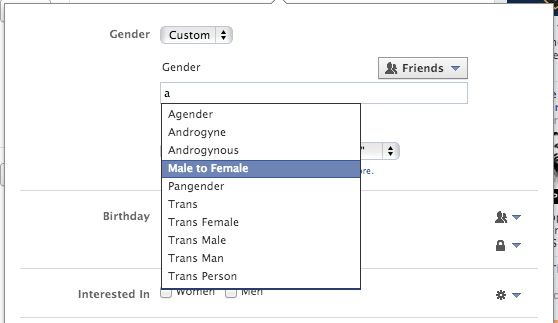Facebook is no longer for males and females only | Ars Technica

Aurich Lawson
Facebook has added a new feature that will allow users to select from a new slate of gender identifiers, according to an announcement on Facebook's Diversity Page. The terms will serve users who do not identify as male or female.
Since 2008, Facebook has required users who made a profile on the site to select from one of two gender options: male or female. The requirement has long bothered those who don't identify with either selection. Facebook's answer to discomfort with the gender binary was that "people can opt out of showing sex on their profile," preventing many people from identifying themselves on their profiles the way people who identify as male or female could.
Facebook has skirted the issue for years, but today it's doing a 180. "We want you to feel comfortable being your true, authentic self," reads the Diversity page post. "An important part of this is the expression of gender, especially when it extends beyond the definitions of just 'male' or 'female.'"
In addition to male or female, Facebook users can now select a third option, "custom," in the gender drop-down. Under custom, users can enter custom descriptors or can select from provided descriptive terms from a large number of dropdown suggestions: gender fluid, gender variant, genderqueer, agender, bigender, cisgender, androgynous, male to female, pangender, and so on. Users can have up to ten descriptors in their profile.


A handful of the new suggested options in Facebook's list of custom gender fill-ins.
Below that, users can also, at long last, select the related pronoun they would like Facebook to refer to them by. The neutral "them" is now available alongside "him" or "her."
Facebook writes that it leaned on its "'Network of Support,' a group of LGBT advocacy organizations" to develop the list. GLAAD, one of the participating organizations, was included in the group. GLAAD President Kate Ellis stated that the new gender options are "a step forward in recognizing transgender people and [allowing] them to tell their authentic story in their own words."
Ellis also writes that "Facebook is on the forefront" of the issue. But former GLAAD vice president of campaigns and programs Allison Palmer says that "users from across the country have been asking for the ability to reflect their gender accurately."
Facebook is hardly the first to offer an option other than male or female, and the issue has long been a target of criticism in the LGBT community. Google+ allows users to identify as "Other," offensive though that is, which would at least attach a gender-neutral descriptor where needed.
However, Google+ has also faced criticism on diversity issues. The company used to enforce a "real identities" policy, which prevented many transgender users from operating under their trans names. Google+ also caused problems for a transgender woman when she intended to send a text message to a colleague under the male identity she was still using at work. She mistakenly sent a Hangout message from her female Google+ profile, which outed her to that colleague and subsequently her workplace.
Facebook's move is well-thought-out and sensitive to its audience, if long overdue. A Facebook representative tells Ars that the transition was a significant engineering undertaking, but the company followed through in the interest of avoiding the term "other."
Facebook switched to using gendered pronouns from a universal neutral pronoun back in 2008, to the dismay of those who didn't identify with a gender binary. Facebook attributed the change to "international translation issues… translations wind up being too confusing when people have not selected a specific sex on their profile." Currently, the custom gender identifiers will only be available for users in US English. Facebook tells Ars that it has no timeline for expansion to other countries and languages.